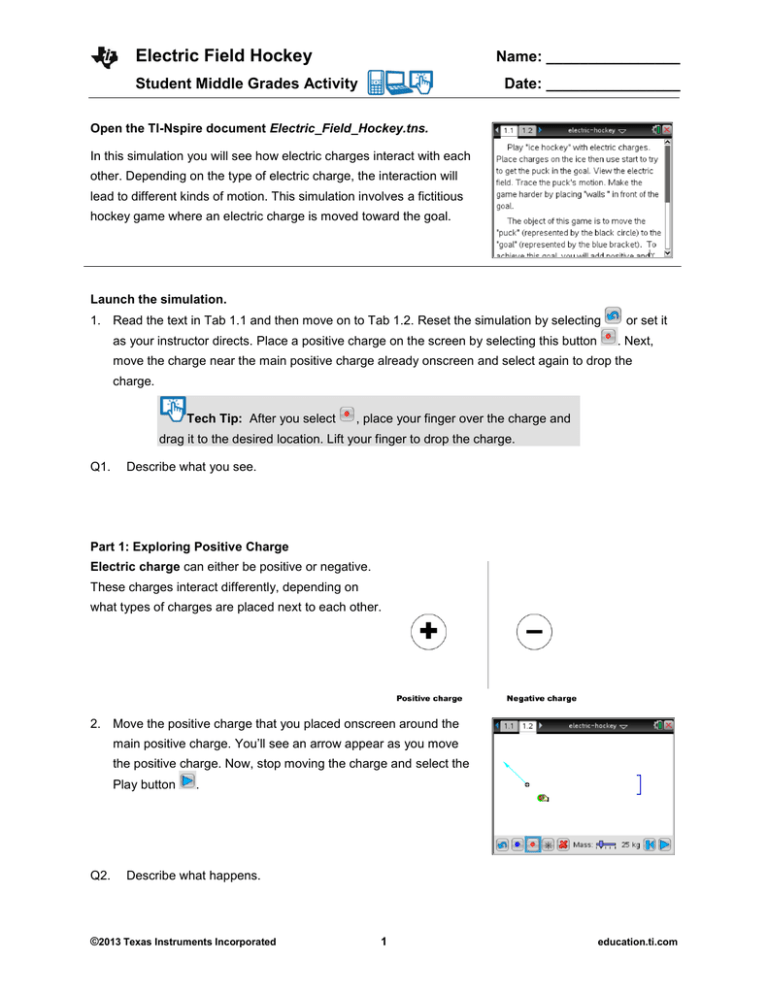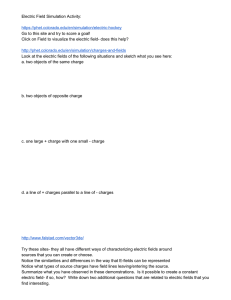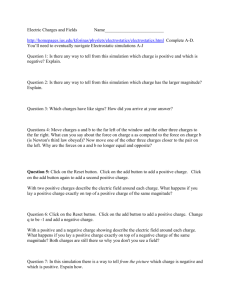Student Activity PDF
advertisement

Electric Field Hockey Name: ________________ Student Middle Grades Activity Date: ________________ Open the TI-Nspire document Electric_Field_Hockey.tns. In this simulation you will see how electric charges interact with each other. Depending on the type of electric charge, the interaction will lead to different kinds of motion. This simulation involves a fictitious hockey game where an electric charge is moved toward the goal. Launch the simulation. 1. Read the text in Tab 1.1 and then move on to Tab 1.2. Reset the simulation by selecting as your instructor directs. Place a positive charge on the screen by selecting this button or set it . Next, move the charge near the main positive charge already onscreen and select again to drop the charge. Tech Tip: After you select , place your finger over the charge and drag it to the desired location. Lift your finger to drop the charge. Q1. Describe what you see. Part 1: Exploring Positive Charge Electric charge can either be positive or negative. These charges interact differently, depending on what types of charges are placed next to each other. 2. Move the positive charge that you placed onscreen around the main positive charge. You’ll see an arrow appear as you move the positive charge. Now, stop moving the charge and select the Play button Q2. . Describe what happens. ©2013 Texas Instruments Incorporated 1 education.ti.com Electric Field Hockey Name: ________________ Student Middle Grades Activity Q3. Select the Rewind button Date: ________________ . Repeat Step 1 for different locations of the positive charge around the main charge. Write a general statement that describes what happens when you place two positive charges near each other. Q4. What do you think would happen if you placed two negative charges next to each other? Part 2: How Electric Charges Interact Electric charges have a property that where like charges (either two positive or two negatives) repel each other, meaning that these charges have a tendency to move away from each other. Unlike charges (one positive and one negative) attract each other, meaning that they have a tendency to move toward each other. You can see how the electric field lines show the behavior of these charges. 3. Select the Reset button . Now place one positive charge onscreen. You want to arrange this charge in such a way that when you run the simulation, the main positive charge hits the goal at the other end of the screen. Q5. Describe the method you used to score a goal. Q6. Now place several more positive charges onscreen and try the same method. Describe what happens. ©2013 Texas Instruments Incorporated 2 education.ti.com Electric Field Hockey Name: ________________ Student Middle Grades Activity Q7. Date: ________________ What happens as you add more positive charges? 4. Select the Rewind button . Now vary the mass of the main positive charge, or the “puck.” Use the slider to increase and decrease the mass of the puck. Q8. Describe what happens to the motion of the main positive charge. Because an electric charge has mass and can be pushed from a stationary position to a state of motion by an electric field from a charged particle, then a charge can pushed by electric force. The electric force equation shown to the right is dependent on the amount of charge (q). The direction of motion depends on whether the charge is positive or negative. 5. Select the Reset button . Now place a number of negative charges onscreen to create an electric field that pulls the main positive charge toward the goal. Q9. Describe your method for getting the positive charge into the goal using negative charges. ©2013 Texas Instruments Incorporated 3 education.ti.com Electric Field Hockey Name: ________________ Student Middle Grades Activity Date: ________________ Part 3: Changing the Direction of Motion 6. Select the Reset button . Now place a number of positive charges onscreen to create the following situation: The charge moves toward the goal. The charge is blocked and prevented from getting to the goal. Q10. Describe your method for preventing the charge from hitting the goal. 7. Select the Reset button . Now place a number of positive and negative charges onscreen to create the same condition as Step 5. Q11. Describe your method for preventing the charge from hitting the goal. ©2013 Texas Instruments Incorporated 4 education.ti.com




